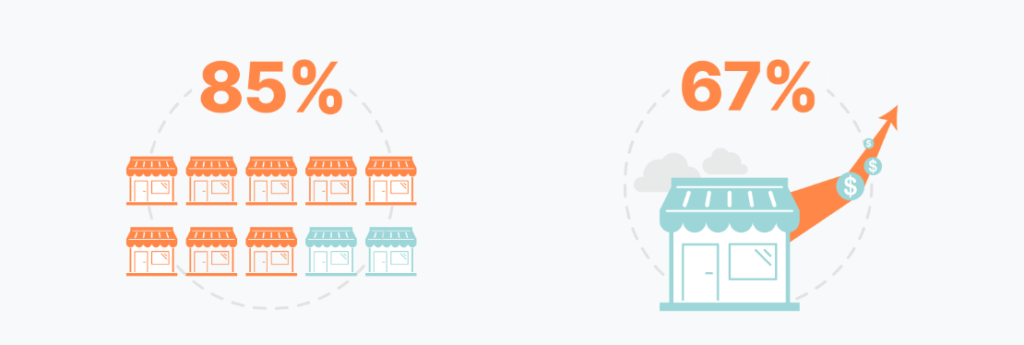To say that entrepreneurs and small businesses have taken a beating since 2020 would be putting it mildly. Small business owners have weathered the COVID-19 pandemic, and supply chain and hiring crises with basically no breaks in between. Now, we’re onto the next challenge — figuring out how to stay afloat amid surging inflation. We’re going to break it all down before we kickstart your game plan to manage high inflation.
Inflation has always been a part of life. Think about it: a million dollars today doesn’t have the same purchasing power as it did in 1980. We’re now in the midst of the biggest jump in prices since that time.

More than eight in ten (85%) small business owners or decision makers are concerned about the impact of inflation on their business, and 67% of small businesses have raised prices because of it, according to the US Chamber of Commerce.
It can seem like this economic swing is entirely out of your control — but don’t despair just yet! Let’s look at:
- What inflation is
- How inflation affects small businesses
- How small businesses can manage inflation
What is Inflation?
Inflation is a measure of the increase in prices of goods over a period of time.
There are two basic types of inflation:
Cost-Push Inflation
When the price increase of specific goods or items, such as oil or food, is large enough to raise overall prices.
Demand-Pull Inflation
When demand outstrips the available amount of goods or services — think a supply shortage — which causes prices to rise.
Inflation can be calculated as a broad rate, for example showing the overall increase in prices or the cost of living in a country. It can also be calculated narrowly, showing the rate increases for specific items or services — think cereal, apples, haircuts or getting a manicure.

To determine the rate of inflation, economists often turn to the consumer price index (CPI). The CPI shows the monthly change in prices US consumers are paying. This change in price represents the rate of inflation that US consumers face as a whole.
While uncomfortable, we’ve been here before: The US Bureau of Labor Statistics reported that over the 12 months ending June 2022, the CPI increased 9.1% — the largest 12-month increase since the 12-month period ending November 1981.
How Does Inflation Affect Businesses?
Since the start of the COVID-19 pandemic, Americans have experienced higher prices for everything from real estate to food due to rising inflation. Read on to see if you’ve already begun feeling the effects of skyrocketing prices.
Your Operating Costs Go Up
Consumers and businesses alike are feeling the hurt from soaring prices for food, rent, gasoline and pretty much everything else. Thirty-three percent of all US small businesses could not pay their full rent on time in May 2022 and 52% said rent has gone up over the past six months, according to small business referral network Alignable.
Inflation has hit every sector — climbing costs for supplies, services and inventory means the cost of running a business is on the rise. Some small business owners have seen their costs increase by as much as 20%. Small business owners across the nation are dipping into emergency funds, savings accounts and running up credit cards just to keep the lights on.
This can put businesses in danger — 47% of small business owners say their businesses are in jeopardy of closing by the fall, which is up 12% from summer 2021, according to Alignable.
You May Have to Raise Prices
It may become inevitable that you’ll have to raise prices on your customers or clients to counter the increase in your operating costs. If you did, you would be in very good company — 67% of business owners have reported raising their prices in the last year alone, according to the U.S. Chamber of Commerce.
You Might Have to Make Tough Decisions to Cut Costs
You can’t control inflation, but you can control your finances. You may have to take a hard look at the expenditures line on your budget and take decisive action to lower your overhead. You may consider reducing inventory, lowering or limiting your marketing spend and taking a hard look at your payroll. Cutting staff hours, working with skeleton crews, laying people off or deciding not to staff up for the holidays are all tough decisions to make. Many entrepreneurs are finding themselves in this position. In the last year, four in ten small business owners have reported they’ve decreased their staff or taken on debt in the form on a business loan to deal with inflation.
You Might Have to Fight For Profitability
Simply put, inflation often impacts your bottom line. Profit margins will shrink — and rising inflation makes reaching your margins more challenging. Profitability can truly become a moving target.
How Small Businesses Can Manage Inflation
Inflation will always be an issue for businesses for the simple reason that the value of items is constantly changing. That said, the rate at which inflation is rising now won’t last forever. That said, economists believe the current rate of inflation will eventually cool back down to more normal levels, around 2%. But business owners can’t wait around for the return to normalcy.
There are two approaches that businesses can employ when facing inflation: stay lean and mean or double down on growth. There’s no right or wrong answer. You can look at your business’ overall health, finances and risk tolerance to create a path forward that makes sense for now and the future.
How to Stay Lean and Mean to Combat Inflation
Choosing to deliberately stay small means making financial decisions to help improve cash flow and keep expenses as low as you possibly can. Some things you can do to stay lean include:
Examine Your Profit Margins
Thoroughly analyzing your profit margins is step one to a successful plan. Taking a hard look at your overall costs and analyzing the margins you’re facing can give you an idea of what changes you might need to make to increase margins while not hurting your business long-term by skimping on your products, services or experience.
Review your Finances and Operations
Think critically about every tool and service you’re paying for and make sure you’re getting ROI. Since payment processing is usually one of the biggest overhead costs behind rent and payroll, you may want to take a look at your payment processor. Review merchant statements to see what your effective rate has been. Have you been hit with a lot of markup from your processor?
Are you being hit with a lot of fees for things that you could fix through PCI compliance, chargeback prevention, and dispute resolution training? Plus, if you’d never considered a surcharge program, you might want to look into whether you offset your processing costs with one. If you want to compare payment processors, you can call a company and ask for a rate review. Heartland provides these cost-cutting programs and offers free rate reviews from our client management team.
Focus on Productivity
Everyone says “time is money” for a reason. If you and your staff are more efficient, you can save money and time to focus on revenue-generating activities. Consider leveraging your POS technology to keep track of inventory and take care of email marketing, social media management and payroll tasks.
Raise Prices The Right Way
Fighting inflation may mean raising prices for your customers. It’s not ideal, but it could become necessary. Consumers already feel like they’re getting hit in every direction with price hikes — so if you raise prices, you have to do it carefully. Try to avoid surprise, across-the-board price increases. If you can, raise prices slowly and start on products or services that impact your margin the most to lessen the sting of the increases. Being honest and upfront and helping customers understand your value will go a long way in keeping repeat customers. You can also consider hosting a promotional event with special discounts, food and drinks or other elements that remind customers that you care.
Go After Customers
Inflation often creates new customer segments. Prices shift and as your competitors lower prices, you’ll need a strategy to be competitive in a price war. Adding price options or tiers can help you retain customers and find new ones. Lower tiers can help repeat customers that are struggling financially, while higher tiers/packages can be marketed as “premium,” which can appeal to customers looking for exclusivity. Diversifying and adding products at lower price points or bundling services can help you find new customers and keep your loyal customers happy as they navigate inflation. Continuing with marketing efforts such as growing your Instagram followers and selling on social media can help you find your target customers.
Invest in growth
Small businesses can also take a look at the current climate and decide that now is the time to invest in growth. A growth strategy focuses on generating enough revenue to outpace inflation and your competitors, who might be battening down the hatches to stay small. If you’re considering growth, you’ll actually take a look at the same things as businesses trying to stay lean — profit margins, finances and operations to start. The difference will be doubling down on steps that will help you now and in the future. If you’re considering growth, you might:
- Take out a small business loan or line of credit: If you’ve done work to build your business credit and feel comfortable taking on debt, you can fund projects that will grow your business. Taking on debt during higher inflation with higher interest rates can be risky — so you may want to consult with a financial advisor first. If you’re a sole proprietor, you may want to weigh the potential risks to your personal finances. The Federal Reserve has already approved interest rate hikes to try to cool down the economy. If you think you’ll need a loan and are on the fence about it, applying sooner rather than later might help you secure the lowest interest rate possible with a lender — as it’s likely the Fed will continue to raise rates.
- Invest in new technology: Whether it’s taking on a new POS system or HR software, your investments can help free you and your management staff from the back-office and improve overall productivity. The right technology can help with overhead costs in the short-term — like flagging your employee schedule if someone is about to go into overtime — and set you up for long-term growth in the future as well.

This Too Shall Pass
People love trotting out this quote when you’re in a tough season of life. And while on first read it may fall flat, there’s an honesty to it you have to admire. No one starts their own business or dives headfirst into entrepreneurship because they’re hoping to avoid hardships or frustration. You do it because you’re fueled by passion, and a belief in your ability to carry on even when the seas get rough.
Smooth seas never made a skilled sailor.
You’ve risen to the challenge before. We know that because resilience is one of the hallmarks of successful entrepreneurs. While small business owners are some of the toughest people around, like anyone, they need support. Get inspired to face everyday business challenges with real startup stories from business owners like you who found their way past bumps — or craters — in the road on The Entrepreneur’s Studio. It’s a welcoming community that reminds you why you started and gives you the support needed to weather the storm.
Questions About Inflation Impacting Your Business?
If you have questions after reading this article, we’re here to help. Please feel free to contact one of the best accounting firms for small businesses or call our office at 916-400-3500.


0 Comments